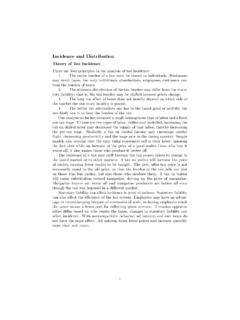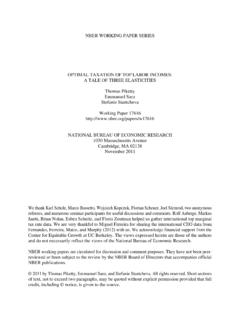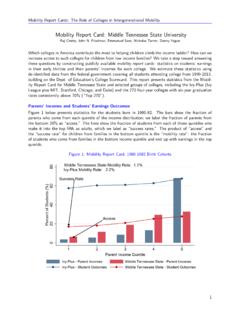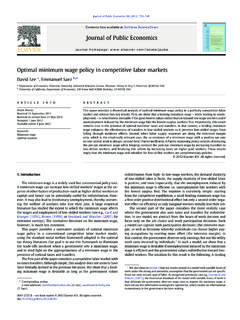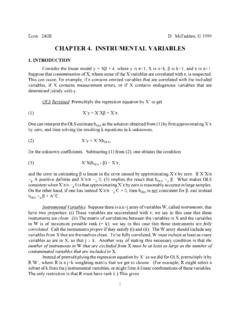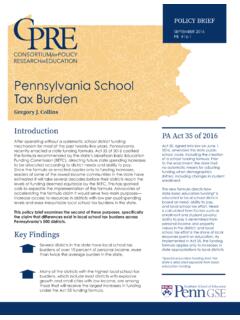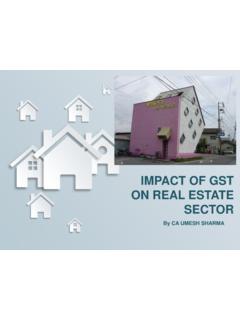Transcription of Tax Incidence and E ciency Costs of Taxation
1 Tax Incidence and Efficiency Costs ofTaxation131 Undergraduate Public EconomicsEmmanuel SaezUC Berkeley1 OUTLINEC hapters The Three Rules of Tax Tax Incidence General Equilibrium Tax The Incidence of Taxation in the United Efficiency Costs of Optimal Commodity Taxation2 Public Finance and Public Policy Jonathan Gruber Third Edition Copyright 2010 Worth Publishers 3 of 36 C H A P T E R 1 9 T H E E Q U I T Y I M P L I C A T I O N S O F T A X A T I O N : T A X I N C I D E N C E tax Incidence Assessing which party (consumers or producers) bears the true burden of a tax. TAX INCIDENCETax Incidence is the study of the effects of tax policies onprices and the distribution of happens to market prices when a tax is introduced orchanged?
2 Examples: what happens when impose $1 per pack tax on cigarettes? Introducean earnings subsidy (EITC)? provide a subsidy for food (food stamps)? effect on price distributional effects on smokers, profits of produc-ers, shareholders, farmers,..This is positive analysis: typically the first step in policy eval-uation; it is an input to later thinking about what policy max-imizes social INCIDENCETax Incidence is not an accounting exercise but an analyticalcharacterization of changes in economic equilibria when taxesare point: Taxes can be shifted: taxes affect directly theprices of goods, which affect quantities because of behavioralresponses, which affect indirectly the price of other prices are constant economic Incidence would be the sameas legislative : Liberals favor capital income Taxation because capital income isconcentrated at the high end of the income distribution.
3 Taxing capitalmeans taxing disproportionately the neglects implicitly general equilibrium price effects: if peoplesave less because of capital taxes, capital stock may go down driving alsothe wages down and hurting workers. The capital tax might be shiftedpartly on Equilibrium Tax IncidencePartial Equilibrium Model:Simple model goes a long way to showing main levies an excise tax on goodxExcise means it is levied on a quantity (gallon, pack, ton, ..).Typically fixed in nominal terms (therefore subject to declinesin real terms)(ad-valorem tax is a fraction of prices ( sales tax), markedautomatically to inflation)Letpdenote the pretax price ofxandq=p+tdenote thetax inclusive price ofx(statutory Incidence is on consumer)6 TAX INCIDENCED emand for goodxisD(q) decreases withq=p+tSupply for goodxisS(p) increases withpEquilibrium condition:Q=S(p) =D(p+t)Start fromt= 0 andS(p) =D(p).
4 We want to characterizedp/dt: effect of a tax increase on price, which determines whobears effective burden of tax:Changedtgenerates changedpso that equilibrium holds:S(p+dp) =D(p+dp+dt) S(p) +S (p)dp=D(p) +D (p)(dp+dt) S (p)dp=D (p)(dp+dt) dpdt=D (p)S (p) D (p)7 TAX INCIDENCEU seful to use elasticities in economics because elasticities areindependent of scalingElasticity:percentage change in quantity when price changesby one percent D=qDdDdq=qD (q)D(q)<0 denotes the price elasticity of demand(consumer faces priceq=p+t) S=pSdSdp=pS (p)S(p)>0 denotes the price elasticity of supplydpdt=D (p)S (p) D (p)= D S D 1 dpdt 0and0 dqdt= 1 +dpdt 18 Public Finance and Public Policy Jonathan Gruber Third Edition Copyright 2010 Worth Publishers 6 of 36 C H A P T E R 1 9 T H E E Q U I T Y I M P L I C A T I O N S O F T A X A T I O N.
5 T A X I N C I D E N C E The Three Rules of Tax Incidence The Statutory burden of a Tax Does Not Describe Who Really Bears the tax Public Finance and Public Policy Jonathan Gruber Third Edition Copyright 2010 Worth Publishers 8 of 36 C H A P T E R 1 9 T H E E Q U I T Y I M P L I C A T I O N S O F T A X A T I O N : T A X I N C I D E N C E The Three Rules of Tax Incidence The Side of the Market on Which the tax Is Imposed Is Irrelevant to the Distribution of the tax Burdens TAX Incidence dpdt= D S DWhen do consumers bear the entire burden of the tax ? (dp/dt=0 anddq/dt= 1) D= 0 [inelastic demand]example: short-run demand for gas inelastic (need to drive to work) S= [perfectly elastic supply]example: perfectly competitive industryWhen do producers bear the entire burden of the tax ?
6 (dp/dt= 1 anddq/dt= 0) S= 0 [inelastic supply]example: fixed quantity supplied D= [perfectly elastic demand]example: there is a close substitute, and demand shifts to this substituteif price Finance and Public Policy Jonathan Gruber Third Edition Copyright 2010 Worth Publishers 11 of 36 C H A P T E R 1 9 T H E E Q U I T Y I M P L I C A T I O N S O F T A X A T I O N : T A X I N C I D E N C E The Three Rules of Tax Incidence Parties with Inelastic Supply or Demand Bear Taxes; Parties with Elastic Supply or Demand Avoid Them Perfectly Inelastic Demand Public Finance and Public Policy Jonathan Gruber Third Edition Copyright 2010 Worth Publishers 13 of 36 C H A P T E R 1 9 T H E E Q U I T Y I M P L I C A T I O N S O F T A X A T I O N : T A X I N C I D E N C E The Three Rules of Tax Incidence Parties with Inelastic Supply or Demand Bear Taxes.
7 Parties with Elastic Supply or Demand Avoid Them Perfectly Elastic Demand Public Finance and Public Policy Jonathan Gruber Third Edition Copyright 2010 Worth Publishers 15 of 36 C H A P T E R 1 9 T H E E Q U I T Y I M P L I C A T I O N S O F T A X A T I O N : T A X I N C I D E N C E The Three Rules of Tax Incidence Parties with Inelastic Supply or Demand Bear Taxes; Parties with Elastic Supply or Demand Avoid Them Supply Elasticities Public Finance and Public Policy Jonathan Gruber Third Edition Copyright 2010 Worth Publishers 18 of 36 C H A P T E R 1 9 T H E E Q U I T Y I M P L I C A T I O N S O F T A X A T I O N : T A X I N C I D E N C E Tax Incidence in Factor Markets Tax Incidence Extensions TAX Incidence : KEY RESULTS1) statutory Incidence not equal to economic incidence2) equilibrium is independent of who nominally pays the tax3) more inelastic factor bears more of the taxThese are robust conclusions that hold with more complicatedmodels12 TAX Incidence .
8 EXTENSIONS1) Market rigidities (suppose there is a minimum or maximumprice) then standard analysis does not carry overExample: minimum wage. Social security taxes on employer on employee. In principle the share of each should not matter aslong as total is constant but minimum wage is computed on net wage(gross wage - employer tax = net wage + employee tax).2) Effects on other markets:Example: Suppose tax on cigarettes increases, if people substitute cigarettesfor cigars then price of cigars increases and part of the burden is shiftedto the cigar market and cigarette demand curves will effects on other markets: tax increases, I am poorer, I have lessto spend on other small, narrow markets such as cigarettes, partial eq.
9 Analysis is areasonable approximation (although effects on substitutes could be impor-tant).13 Public Finance and Public Policy Jonathan Gruber Third Edition Copyright 2010 Worth Publishers 20 of 36 C H A P T E R 1 9 T H E E Q U I T Y I M P L I C A T I O N S O F T A X A T I O N : T A X I N C I D E N C E Tax Incidence in Factor Markets Tax Incidence Extensions Impediments to Wage Adjustment Efficiency Costs of TaxationThus far, we have focused on the Incidence of governmentpolicies: how price interventions affect equilibrium prices andfactors returns: how policies affect thedistributionof the pieA second general set of questions is how taxes affect thesizeof the.
10 Income taxationGovernment raises taxes to raise revenue to finance publicgoods or to redistribute income from rich to raising tax revenue generally has an efficiency cost: togenerate $1 of revenue, need to reduce welfare of the taxedindividuals by more than $1 Efficiency Costs come from distortion of behavior15 Efficiency Costs of TaxationDeadweight burden (also called excess burden ) of Taxation isdefined as the welfare loss (measured in dollars) created by atax over and above the tax revenue generated by the taxIn the simple supply and demand diagram, welfare is measuredby the sum of the consumer surplus and producer surplusThe welfare loss of Taxation is measured as change in con-sumer+producer surplus minus tax collected.
